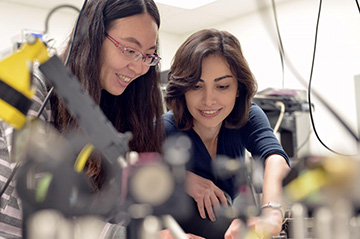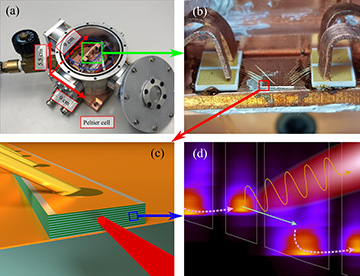
Lead author Ning Wang (left) and OSA Fellow Mona Jarrahi of UCLA, with their terahertz detector setup. [Image: UCLA Engineering]
Research in the terahertz (THz) radiation band, between infrared and microwave on the electromagnetic spectrum, promises new insights in areas ranging from astrophysics to bioimaging. But for some applications, the route to compact and sensitive THz sources and detectors has included a nagging hurdle: many must operate at frigid cryogenic temperatures, which boosts device footprint and complexity. Recently published studies by two groups have now come up with ways take some of the chill off of detecting and creating THz radiation.
Astrophysical tool
On the detection side, the team of OSA Fellow Mona Jarrahi at the University of California, Los Angeles (UCLA), USA, focused particularly on the uses of THz radiation in astronomy (Nat. Astron., doi: 10.1038/s41550-019-0828-6). This radiation band will likely prove particularly important in emerging studies of planet and star formation, as well as of interstellar water and organic molecules that could illuminate whether extrasolar planets hold the possibility of life.
Getting at those questions requires instruments that operate near the quantum sensitivity limit, to extract a usable signal from the handful of deep-space THz photons that find their way to Earth-based telescopes. And there’s the rub: to get at that limit in a heterodyne THz detector commonly requires superconductor-insulator-superconductor (SIS) mixers—which are happy only at cryogenic temperatures—for downconversion from THz frequencies to the RF band used for signal processing. Moreover, such THz detectors tend to sport relatively limited spectral bandwidth, meaning that several different devices must be used for detection across the wider swath of THz radiation that’s of interest.
Plasmonic solution
Jarrahi and her team attacked the problem by completely rethinking the detector architecture. Most important, they replaced the superconducting mixer setup with a photomixer including plasmonic contacts. The contacts consist of 50-nm-thick, closely spaced titanium/gold gratings, tied to a logarithmic spiral antenna atop a photo-absorbing semiconductor substrate.
The grating, pumped with an optical beam at a THz beat frequency, converts the incoming radiation to surface plasmon waves—tightly confined electron oscillations at the metal-dielectric interface—at THz frequencies. The result is a well-behaved local oscillator that can be mixed with the incoming THz signal from (for example) an astronomical telescope, creating a downconverted beat signal that can easily be handled by standard RF signal-processing electronics.
Broadband, room-temperature operation
The UCLA researchers tested a fabricated prototype of their design, and found that it could operate effectively at room temperature to a sensitivity only around three times above the quantum noise limit. Moreover, by tweaking the antenna geometry and sweeping the tunable optical pump beam through a range of frequencies, the single, integrated device could pick up THz signals across a frequency range from 0.1 to 5 THz. By contrast, the study authors point out, current conventional THz detection technologies would require “a large number of cryogenically cooled SIS mixers, HEB [hot electron bolometer] mixers and terahertz local oscillators” to achieve comparable sensitivities across a similar spectral range.
In a press release accompanying the research, Jarrahi and her colleagues noted that the new device could prove especially useful in space-based telescopes, where weight and logistical concerns make it difficult to pack along the tanks of coolant required for long-term operation of a conventional, cryogenic THz detection system. And the team believes that, in addition to its astronomical uses, the compact room-temperature detector could prove useful for applications in atmospheric science, gas sensing and fundamental quantum optics. “Looking in terahertz frequencies,” says Jarrahi, “allows us to see details that we can’t see in other parts of the spectrum.”
QCLs for THz
Meanwhile, across the Atlantic, the research group of OSA Fellow Jérôme Faist at ETH Zurich, Switzerland, has been looking at how to make compact THz light sources that don’t require cryogenic cooling (Appl. Phys. Lett., doi: 10.1063/1.5110305). One obvious candidate, at least on the compactness front, is quantum cascade lasers (QCLs)—injection lasers based on semiconductor heterostructures first demonstrated by Faist and colleagues at Bell Laboratories in 1994.
QCLs have found considerable use, for example, as the light sources underpinning compact mid-infrared sensors for environmental applications (see “Air-Quality Monitoring in the Mid-Infrared,” OPN, November 2015). QCL development for the THz spectral band has also come a long way. But here, despite substantial efforts to boost their maximum allowable operating temperature, THz QCLs still must be chilled to below 200 K (–73 °C). That means that, no matter how compact the semiconductor laser structures themselves are, they must travel with cryogenic cooling equipment that makes devices based on them costlier, bulkier and less mobile.
A two-well design
The ETH Zurich team’s thermoelectrically cooled THz QCL (top left) consists of a laser chip (top right) consisting of a set of several laser ridges (bottom left). The laser design is based on a computationally designed two-quantum-well structure (bottom right). [Image: Faist group, ETH Zurich] [Enlarge image]
To cross the 200 K barrier and eliminate the need for cryogenic cooling, Faist’s team, including lead authors Lorenzo Bosco and Martin Franckié, focused on a structure including two quantum wells per period—known, from previous modeling and experiments, to be a possible route to higher operating temperatures in the THz band. But designing and optimizing such structures is devilishly difficult and sensitive. So the team used non-equilibrium Green’s function numerical modeling, a computationally intensive but efficient scheme, to zero in on an optimized two-well structure for the device.
Ditching cryogenics
On fabricating the modeled device, the team found that it could lase effectively at temperatures as high as 210 K (–63 °C)—not exactly balmy, but a full 10 K above the maximum operating temperature of previous THz QCLs. While a 10 K improvement doesn’t sound like much, it was enough to allow the team to ditch cryogenic cooling equipment altogether, and instead use a standard, small-footprint thermoelectric cooler to chill the laser. That makes the work, according to the team, the first demonstration of a THz QCL using thermoelectric rather than cryogenic cooling.
That advantage, the team believes, could “pave the way toward a new generation of on-chip, portable THz devices based on high-power THz coherent sources.” The researchers see potential applications in noninvasive biomedical and industrial imaging, security screening, and other areas.

